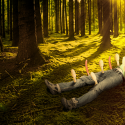If you are familiar with our show, you know we often focus on surviving the rare, catastrophic things that can happen to you. Since you might not need to know how to survive a box jellyfish attack, we thought we’d change things up a bit and tell you how to survive the most common accidental deaths.
While we don’t want to alarm you, most accidental deaths can occur right in your home. Poisoning, falls, choking, drowning, fires and burns top the list of the most deadly accidents. So how can you make sure you don’t become their next victim? How can spitting save you? Why is absent-minded behavior deadly? How can a myth kill you?
So, you survived your trip to Africa without any life-threatening animal attacks and are finally home. It’s common to feel relief when entering your home. But every day, many people die in their homes.
Number 1: Poisoning
According to the American Association of Poison Control Centers’ National Poison Data System, 2,619 human exposures resulted in death in 2019. And the 55 U.S. poison control centers gave guidance over the phone for more than 2.1 million people exposed to poison. One exposure to poison gets reported to U.S. poison control centers every 15 seconds. And the age group most often exposed to poison was one- and two-year-olds. You’ll know you may have been poisoned if you have any of the following symptoms: vomiting, difficulty breathing, drowsiness, redness around your mouth or mental confusion.
Before you do anything else, call your medical emergency helpline immediately. Tell the nurse on the phone your age, weight, information about the poison, all medications you take and describe your symptoms. Tell them how much poison you may have ingested. Also, read the label on the packaging to the nurse. Then they’ll know which poison they are dealing with. And if the poison gets in your eyes, very gently wash it out using cool or lukewarm water for 15 minutes.
Number 2: Falls
Stairs are one of the most common places where people fall, and careless behavior on stairs causes a disproportionate amount of deaths and severe injuries. Many injuries occur due to poor visibility or distraction.
In 2015, a SmartRisk study in Canada showed that one person dies every day after falling on stairs, and 270 more got admitted to hospitals. That’s 365 preventable deaths and almost 100,000 injuries per year.
The best way to survive a fall is to prevent it from happening. You can do that by staying alert to your surroundings and exercising to maintain your balance.
If you find yourself falling, try to cover your head to protect it from injury. Avoid landing on bone and try to land on the more padded areas of your body, like your buttocks. This will help you avoid breaking an elbow, knee or shoulder.
Number 3: Choking
Choking occurs when an object gets lodged in the throat or windpipe and blocks the airflow. In adults, the most common cause of choking is a piece of food lodged in the wrong place. In young children, swallowing small objects can lead to choking. Choking cuts off oxygen to the brain, which is called cerebral hypoxia. Your brain cells are sensitive to a lack of oxygen.
Some brain cells start dying less than five minutes after their oxygen supply is cut off. Brain hypoxia can rapidly cause severe brain damage or death. To survive choking, ignore the myths such as raising hands above the head or patting on the back. Instead, try not to panic, and call 911 or your country’s emergency help number immediately. You may not be able to say what you are going through, but the operator can pick up clues when they hear you coughing and struggling to breathe.
Number 4: Drowning
Remember that drowning is a silent killer. Victims are rarely able to call for help. According to the WHO, worldwide, about 236,000 people die from drowning every year. It’s the third biggest cause of unintended death among adults and the second leading cause of death among children worldwide. To help a drowning person, call for emergency help immediately.
Only get into the water to save the person if you are properly trained to provide emergency assistance. Remember to take a flotation device with you as you jump into the water to save them. And if you are the person drowning, try not to panic. Panicking and thrashing about in the water will only make things worse.
Try to keep your head out of the water as much as possible, and try not to hyperventilate. Breathing normally and keeping your lungs filled with air will help you float. Scream, shout and wave. Drawing attention to yourself will hopefully result in a rescue.
Number 5: Fires and Burns
In 2010, fire departments in the United States got called to 44,900 fires due to someone starting a fire. These fires caused 90 civilian fatalities, 890 civilian injuries, and $210 million in direct property damage. Nearly half of the people who set fires at home were five years old or younger.
Kids in preschool and kindergarten are most likely to set fires when playing with matches or lighters, and they usually die in these fires. Residential fires and fire-related deaths are usually caused by cooking, heating, electrical distribution and lighting equipment, intentionally started fires and smoking. The kitchen is the most common place for fires, so stay in the room when you’re cooking with high heat, such as frying, boiling, or broiling.
If you have to step away, ask someone for help or turn off the appliance before you leave. Keep a Class B fire extinguisher close to high-traffic areas that could be at risk of fire. The most effective way to use an extinguisher is to aim the nozzle low, at the base of the fire.
Don’t aim higher up. But your home isn’t the only place where a fire could strike. What should you do if you’re out in the woods and find yourself surrounded by flames?
Sources
- “Poisoning: First Aid“. 2022. Mayo Clinic.
- “Poison Control And Unintentional Poisoning“. 2022. Who.Int.
- “Poisoning: First Aid“. 2022. Mayo Clinic.
- “A Review Of Stairway Falls And Stair Negotiation: Lessons Learned And Future Needs To Reduce Injury“. Jacobs, Jesse V. 2016. Gait & Posture
- “Slips And Falls Around The Home Can Be Deadly”.Hayes, Kim. 2022.. AARP.

















